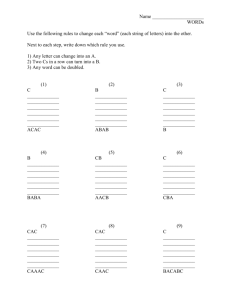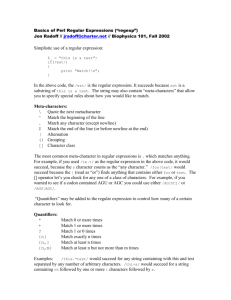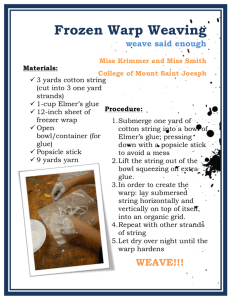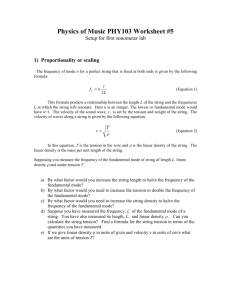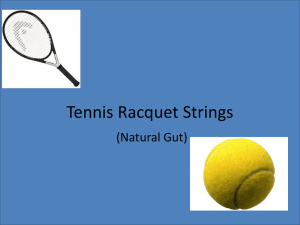The Physics of Rogaining
advertisement
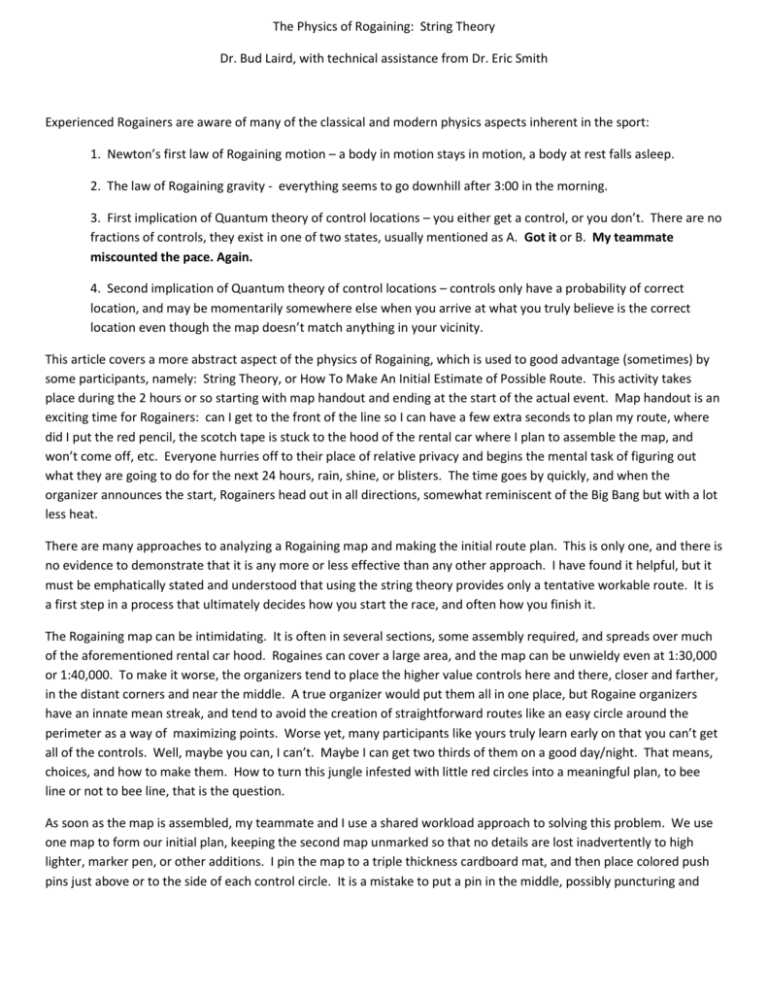
The Physics of Rogaining: String Theory Dr. Bud Laird, with technical assistance from Dr. Eric Smith Experienced Rogainers are aware of many of the classical and modern physics aspects inherent in the sport: 1. Newton’s first law of Rogaining motion – a body in motion stays in motion, a body at rest falls asleep. 2. The law of Rogaining gravity - everything seems to go downhill after 3:00 in the morning. 3. First implication of Quantum theory of control locations – you either get a control, or you don’t. There are no fractions of controls, they exist in one of two states, usually mentioned as A. Got it or B. My teammate miscounted the pace. Again. 4. Second implication of Quantum theory of control locations – controls only have a probability of correct location, and may be momentarily somewhere else when you arrive at what you truly believe is the correct location even though the map doesn’t match anything in your vicinity. This article covers a more abstract aspect of the physics of Rogaining, which is used to good advantage (sometimes) by some participants, namely: String Theory, or How To Make An Initial Estimate of Possible Route. This activity takes place during the 2 hours or so starting with map handout and ending at the start of the actual event. Map handout is an exciting time for Rogainers: can I get to the front of the line so I can have a few extra seconds to plan my route, where did I put the red pencil, the scotch tape is stuck to the hood of the rental car where I plan to assemble the map, and won’t come off, etc. Everyone hurries off to their place of relative privacy and begins the mental task of figuring out what they are going to do for the next 24 hours, rain, shine, or blisters. The time goes by quickly, and when the organizer announces the start, Rogainers head out in all directions, somewhat reminiscent of the Big Bang but with a lot less heat. There are many approaches to analyzing a Rogaining map and making the initial route plan. This is only one, and there is no evidence to demonstrate that it is any more or less effective than any other approach. I have found it helpful, but it must be emphatically stated and understood that using the string theory provides only a tentative workable route. It is a first step in a process that ultimately decides how you start the race, and often how you finish it. The Rogaining map can be intimidating. It is often in several sections, some assembly required, and spreads over much of the aforementioned rental car hood. Rogaines can cover a large area, and the map can be unwieldy even at 1:30,000 or 1:40,000. To make it worse, the organizers tend to place the higher value controls here and there, closer and farther, in the distant corners and near the middle. A true organizer would put them all in one place, but Rogaine organizers have an innate mean streak, and tend to avoid the creation of straightforward routes like an easy circle around the perimeter as a way of maximizing points. Worse yet, many participants like yours truly learn early on that you can’t get all of the controls. Well, maybe you can, I can’t. Maybe I can get two thirds of them on a good day/night. That means, choices, and how to make them. How to turn this jungle infested with little red circles into a meaningful plan, to bee line or not to bee line, that is the question. As soon as the map is assembled, my teammate and I use a shared workload approach to solving this problem. We use one map to form our initial plan, keeping the second map unmarked so that no details are lost inadvertently to high lighter, marker pen, or other additions. I pin the map to a triple thickness cardboard mat, and then place colored push pins just above or to the side of each control circle. It is a mistake to put a pin in the middle, possibly puncturing and destroying an important contour line bend or other item of information right where you need it most (the control location). Also, covering up the control number creates headaches, so pin placement should be near the edge of the control, but not obstructing anything. We have settled on two colors of pins – high value and low value – having found out that trying to use more levels of value than that ends up with more confusion than clarity. We add two other colors of pins – one for water locations and one for places we have to go to get around a lake, big cliff, nuclear waste dump site, whatever. A big non crossable terrain feature has to be high priority in any good initial plan. Once the map is suitably pinned up, it is time for String Theory. I bring with me a set of strings that are premeasured in terms of distance per unit time (usually in four hour segments) for that map scale under anticipated conditions of terrain ruggedness. Typically, I will have reviewed maps of the area ahead of time, so I know whether it will be primarily flat and rolling terrain, hilly and/or many water features, or high impact up and down all day, all night, Mary Ann (song lyric circa 1955?). Based on a great deal of accumulated (usually painful) experience, I use a distance per unit time figure of 3.5 km/hr. for easy terrain, 3.2 km/hr. for hilly, and 3.0 km/hr. for rough stuff for daytime work, and about 1.5 km/hr for night. This is just what works for me, post one knee surgery and one back injury. Other people may find different figures work for them. For beginners, it should be emphasized that night navigation is several orders of magnitude more difficult than daytime. Experience in Night O does not readily translate into any kind of proficiency at long distance cross country navigation under low/no light conditions. Of course, the tendency for fog to settle in during the night adds to the difficulty. Distance and accuracy should be underestimated until experience proves otherwise. On Rogaines shorter than 24 hrs., I use slightly higher figures. The string has a loop at each end, and is measured and marked at appropriate intervals with black marker to indicate 4 hr., 8 hr., 12 hr., etc. distance at the predicted ground speed. A word about ground speed and distance– those figures may seem incredibly slow even for an old Buzzard like yours truly, but we are using this as an estimate of point to point progress, not actual route over the terrain, so it is really an empirically derived formula that works pretty well given the average bends/turns/wanderings that actually occur. The string depicts an “average rate” of accomplishment of reaching the objectives, which is something that everyone needs to work out for themselves. Looking over actual GPS logger distances as compared to string length estimations and converting time intervals to distance, it is our experience that we cover about 20 to 25 % more distance on actual route than what is measured by the string (which means our actual rate of travel is higher than the string estimate). The greater actual distance traveled offsets the “point to point” distance of the string, so the estimate is pretty close in terms of actual time. Everyone has to work out their own parameters on this, taking into account that the map plan is more of a Poincare map which leaves out the orbits around the difficult controls and only shows direct approach and departure from these strange attractors marked by little orange and white flags. Chosen string in hand, it is time to tame the wild map. Placing one end loop over the start/finish, I wind the string from pinned control to pinned control, creating a point to point line that covers as much area as possible given that the loop on the other end of the string needs to reach the start/finish to close the figure. The higher point controls with their chosen color stand out and I try to direct the string towards them as much as possible. Care is taken to run the string around pins that mark the location of out of bounds, uncrossable, or just plain ugly looking terrain that we do not want to visit. Looking at the first bit of string art completed on the map, it is easy to see where adjacent high point controls might be neglected, where dog legs are too long, and where there is good “yield” for each four hour segment or bad yield. After a few changes, a preliminary route is laid out for closer examination. At this point, one of us calls out the controls in order, the other one writes them down and totals up the points. Then, we look for other ways of running the string to pick up more of the high pointers by sacrificing some of the controls that are low pointers. The string is very movable, very quickly, and you can always go back to the initial list if a second approximation has a lower point yield. Each of us ponders the latest approximation, and makes suggestions of changes that might reduce doglegs, or favor easier terrain. The string allows easy visualization of the degree to which trail/road segments lie along the route, or across it, which in turn suggests changes in control order to improve conditions of travel. We typically write two or three lists of possible control order before settling on a proposed route, and it is important to write each one down before moving the string to new configurations. At this point, having agreed on a proposed route, we know that it is within our physical capability. Now, we start looking at the actual route between controls, working out how we will transit the distance and what reasonable attack points may be present. If we find anything too steep, too vague, or JDLR (Just Don’t Look Right), then an alternate sequence of controls in the immediate area is discussed and a decision is made on route change. We determine whether it would be better to go in one direction around the course or the other based on a number of things, with particular attention to what area we might be in during darkness, and what the possible run in to the finish is going to look like in terms of available road/trail in case time becomes an issue. Once we have agreement on a workable plan, we run the string around the final list of controls to make sure that we have not over/under estimated our likely distance overall. Now, with the string in place, we identify possible cutouts and add ins. Cutouts are controls that can be dropped if we are behind time, without abandoning the plan altogether. Dog legs that involve lower point controls are prime candidates for cutting out. Add ins are controls that can be added if we are ahead of time. On our list of controls, we circle the cutouts and write the add ins over beside the column of control numbers. At this point, we are ready to begin marking the map (the other, as mentioned before, is left blank so that nothing is obscured). We write the intended list of controls across the top edge and down the right side of the map, with cutouts circled and add ins written in from the edge for easy reference. The predicted 4 hr., 8 hr., etc. location is indicated by writing that next to the control that should be reached by that time, and this is also written on the map itself by the control for easy reference. I also like to put a 1 hour to end of event mark on the map – reach that point by hour 23 or start running straight in for the finish. The job is not done. There still remains the work of analyzing best approaches to minimize climb and obstacles, reasonable detours to use to take advantage of roads/trails, and closer scrutiny of the area of the night section. Until, of course, time runs out on the planning phase and it’s time to get going. Throughout the event, the plan will be revisited and changed as we find out what is really out there, which is usually a bit different than what we optimistically envision at the start. Using string theory, an approximate route can be quickly assembled for further analysis. It is only a first step, however, and needs a lot of analysis and modification before a best plan is in hand. With a little practice and experience, a team can use an approach like this to put themselves on a course that is not too short or too long, and that is a big plus at the start of the event. There are many approaches to choosing a plan in Rogaining, this is just one that may be of use. It should be mentioned that some teams use pipe cleaners to route plan in a similar fashion. Unfortunately, theoretical physics has not yet reached the point where pipe cleaners can be used as a Theory Of Everything ( TOE, as in both big ones lose their nails) in understanding and predicting true Rogaine performance. Happy, Rogaining, see you out there. Other Physics Laws of Rogaining: 4. Heisenberg Principle of Rogaining Uncertainty – You can determine your exact location by keeping close map contact and watching the terrain, or you can know your actual speed by pace counting and tracking elapsed time from last control. You cannot know both at the same time, because you will get confused and end up in New Jersey, probably near my home town. 5. Chaos Theory – What your pack looks like after 4 hours. 6. Rogaining Score Special Theory of Relativity – Although viewing the results within the space time framework of the Hash House at the end of the event, you actually travelled much faster and scored many more points than all the other competitors while you were actually out on the course, or in talking about it later, it is only at the Hash House that the measurements showed that you didn’t do as well as you thought you did. Bud Laird Teams Over Yawnder and Buzzards Follow Us.




